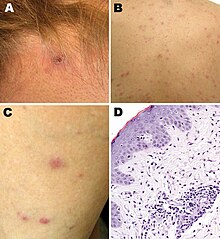| Rickettsia parkeri | |
|---|---|

| |
| Rickettsia parkeri rickettsiosis skin lesions: A - eschar after tick bite on neck; B, C - papulovesicular rash on back and leg; D - micrograph of biopsy specimen | |
| Scientific classification | |
| Domain: | Bacteria |
| Phylum: | Pseudomonadota |
| Class: | Alphaproteobacteria |
| Order: | Rickettsiales |
| Family: | Rickettsiaceae |
| Genus: | Rickettsia |
| Species group: | Spotted fever group |
| Species: | R. parkeri
|
| Binomial name | |
| Rickettsia parkeri Lackman et al., 1965
| |
Rickettsia parkeri (abbreviated R. parkeri) is a gram-negative intracellular bacterium. The organism is found in the Western Hemisphere and is transmitted via the bite of hard ticks of the genus Amblyomma. R. parkeri causes mild spotted fever disease in humans, whose most common signs and symptoms are fever, an eschar at the site of tick attachment, rash, headache, and muscle aches. Doxycycline is the most common drug used to reduce the symptoms associated with disease.